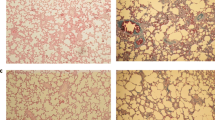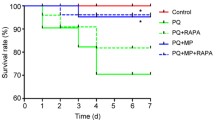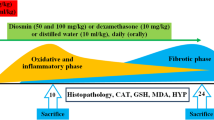Abstract
Paraquat-induced pulmonary fibrosis is a progressive and fatal interstitial lung disease, a condition for that, there is no effective treatment and its prognosis is appalling. Since multiple coactivated pathways are involved, targeting these pathways using combination regimens is plausible for successful therapy. So, the aim of the present study was to evaluate the therapeutic efficacy of pirfenidone–vitamin E combination therapy in (paraquat) PQ-induced lung fibrosis model. After the development of PQ-induced lung fibrosis, pirfenidone, vitamin E, pirfenidone plus vitamin E, and water (as a vehicle) were orally administered for 14 consecutive days (From day 14 to day 28). The comparison of efficacies was performed by evaluating histopathology changes, hydroxyproline content, and oxidative stress. Either pirfenidone or vitamin E solely could recover the pathological changes of paraquat, decreased lipid peroxidation, and restored the antioxidant enzymes towards normal values. Hydroxyproline content was significantly reduced by both pirfenidone and vitamin E administration. Concurrent treatment with pirfenidone and vitamin E intensified all of these therapeutics effects indicating more potent antifibrotic and anti-inflammatory impacts. Therefore, pirfenidone plus vitamin E offers potential as a combination therapy for the treatment of paraquat-induced pulmonary fibrosis.


Similar content being viewed by others
Abbreviations
- Paraquat:
-
(PubChem CID: 15938)
- Pirfenidone:
-
(PubChem CID: 40632)
- Vitamin E:
-
(PubChem CID: 14985)
- Malondialdehyde:
-
(PubChem CID: 10964)
- Hydroxyproline :
-
(PubChem CID: 5810)
- PF:
-
Pirfenidone
- PQ:
-
Paraquat
- CAT:
-
Catalase
- SOD:
-
Super oxide dismutase
- MDA:
-
Malondialdehyde
- HP:
-
Hydroxyproline
References
Aebi H (1984) [13] Catalase in vitro. Methods Enzymol 105:121–126
Ashcroft T, Simpson JM, Timbrell V (1988) Simple method of estimating severity of pulmonary fibrosis on a numerical scale. J Clin Pathol 41:467–470
Bese N et al (2007) Vitamin E protects against the development of radiation-induced pulmonary fibrosis in rats. Clin Oncol 19:260–264
Beyer WF, Fridovich I (1987) Assaying for superoxide dismutase activity: some large consequences of minor changes in conditions. Anal Biochem 161:559–566
Bus JS, Gibson JE (1984) Paraquat: model for oxidant-initiated toxicity. Environ Health Perspect 55:37
Card JW, Racz WJ, Brien JF, Massey TE (2003) Attenuation of amiodarone-induced pulmonary fibrosis by vitamin E is associated with suppression of transforming growth factor-β1 gene expression but not prevention of mitochondrial dysfunction. J Pharmacol Exp Ther 304:277–283
Cherniack RM, Colby TV, Flint A, Thurlbeck WM, Waldron J, Ackerson L, King TE Jr (1991) Quantitative assessment of lung pathology in idiopathic pulmonary fibrosis. The BAL Cooperative Group Steering Committee. Am Rev Respir Dis 144:892–900. https://doi.org/10.1164/ajrccm/144.4.892
Day BJ (2008) Antioxidants as potential therapeutics for lung fibrosis. Antioxid Redox Signal 10:355–370
Deger Y, Yur F, Ertekin A, Mert N, Dede S, Mert H (2007) Protective effect of α-tocopherol on oxidative stress in experimental pulmonary fibrosis in rats. Cell Biochem Funct 25:633–637
Devaraj S, Jialal I (2005) α-Tocopherol decreases tumor necrosis factor-α mRNA and protein from activated human monocytes by inhibition of 5-lipoxygenase. Free Radic Biol Med 38:1212–1220
Dou T et al. (2015) Nrf2/ARE pathway involved in oxidative stress induced by paraquat in human neural progenitor cells. Oxidative medicine and cellular longevity 2016
Elenga N et al (2018) Clinical features and prognosis of paraquat poisoning in French Guiana: a review of 62 cases. Medicine 97
Fois AG et al (2018a) Evaluation of oxidative stress biomarkers in idiopathic pulmonary fibrosis and therapeutic applications: a systematic review. Respir Res 19:51
Fois AG et al (2018b) Antioxidant activity mediates pirfenidone antifibrotic effects in human pulmonary vascular smooth muscle cells exposed to sera of idiopathic pulmonary fibrosis patients. Oxidative Med Cell Longev:2018
Futamura Y (1996) Toxicity of amiodarone on mouse pulmonary endothelial cells cultured with or without alveolar macrophages. J Toxicol Sci 21:253–267
Gao F, Kinnula VL, Myllärniemi M, Oury TD (2008) Extracellular superoxide dismutase in pulmonary fibrosis. Antioxid Redox Signal 10:343–354
Gawarammana IB, Buckley NA (2011) Medical management of paraquat ingestion. Br J Clin Pharmacol 72:745–757. https://doi.org/10.1111/j.1365-2125.2011.04026.x
Ghazi-Khansari M, Mohammadi-Karakani A, Sotoudeh M, Mokhtary P, Pour-Esmaeil E, Maghsoud S (2007) Antifibrotic effect of captopril and enalapril on paraquat-induced lung fibrosis in rats. J Appl Toxicol 27:342–349. https://doi.org/10.1002/jat.1212
Hemmati A, Nazari Z, Ranjbari N, Torfi A (2008) Comparison of the preventive effect of vitamin C and E on hexavalent chromium induced pulmonary fibrosis in rat. Inflammopharmacology 16:195–197
Hubner RH et al (2008) Standardized quantification of pulmonary fibrosis in histological samples. Biotechniques 44(507-511):514–507. https://doi.org/10.2144/000112729
Iyer SN, Hyde DM, Giri SN (2000) Anti-inflammatory effect of pirfenidone in the bleomycin-hamster model of lung inflammation. Inflammation 24:477–491
Kachel D, Moyer T, Martin W (1990) Amiodarone-induced injury of human pulmonary artery endothelial cells: protection by alpha-tocopherol. J Pharmacol Exp Ther 254:1107–1112
Kalantar M, Khodayar MJ, Kalantari H, Khorsandi L, Hemmati AA (2018) Therapeutic effect of gallic acid against paraquat-induced lung injury in rat. Jundishapur J Nat Pharm Prod 13:13
Kandhare AD, Mukherjee A, Ghosh P, Bodhankar SL (2016) Efficacy of antioxidant in idiopathic pulmonary fibrosis: a systematic review and meta-analysis. EXCLI J 15:636
Kar S, Biswas S, Banerjee ER (2016) Evaluating the ameliorative potential of plant flavonoids and their nanocomposites in bleomycin induced idiopathic pulmonary fibrosis. Biomed Res Therapy 3:707–722
Li T, Yang X, Xin S, Cao Y, Wang N (2017) Paraquat poisoning induced pulmonary epithelial mesenchymal transition through Notch1 pathway. Sci Rep 7:924
Liu M-W et al (2016) Radix puerariae extracts ameliorate paraquat-induced pulmonary fibrosis by attenuating follistatin-like 1 and nuclear factor erythroid 2p45-related factor-2 signalling pathways through downregulation of miRNA-21 expression. BMC Complement Altern Med 16:1
Oku H, Nakazato H, Horikawa T, Tsuruta Y, Suzuki R (2002) Pirfenidone suppresses tumor necrosis factor-α, enhances interleukin-10 and protects mice from endotoxic shock. Eur J Pharmacol 446:167–176
Oku H et al (2008) Antifibrotic action of pirfenidone and prednisolone: different effects on pulmonary cytokines and growth factors in bleomycin-induced murine pulmonary fibrosis. Eur J Pharmacol 590:400–408
Pourgholamhossein F et al (2016) Thymoquinone effectively alleviates lung fibrosis induced by paraquat herbicide through down-regulation of pro-fibrotic genes and inhibition of oxidative stress. Environ Toxicol Pharmacol 45:340–345. https://doi.org/10.1016/j.etap.2016.06.019
Pourgholamhossein F et al (2018) Pirfenidone protects against paraquat-induced lung injury and fibrosis in mice by modulation of inflammation, oxidative stress, and gene expression. Food Chem Toxicol 112:39–46
Rasooli R, Pourgholamhosein F, Kamali Y, Nabipour F, Mandegary A (2018) Combination therapy with pirfenidone plus prednisolone ameliorates paraquat-induced pulmonary fibrosis. Inflammation 41:134–142. https://doi.org/10.1007/s10753-017-0671-9
Reddy GK, Enwemeka CS (1996) A simplified method for the analysis of hydroxyproline in biological tissues. Clin Biochem 29:225–229
Ruch RJ, Bandyopadhyay S, Somani P, Klaunig JE (1991) Evaluation of amiodarone free radical toxicity in rat hepatocytes. Toxicol Lett 56:117–126
Salazar-Montes A, Ruiz-Corro L, López-Reyes A, Castrejón-Gómez E, Armendáriz-Borunda J (2008) Potent antioxidant role of pirfenidone in experimental cirrhosis. Eur J Pharmacol 595:69–77
Schaefer C, Ruhrmund D, Pan L, Seiwert S, Kossen K (2011) Antifibrotic activities of pirfenidone in animal models. Eur Respir Rev 20:85–97
Seifirad S, Keshavarz A, Taslimi S, Aran S, Abbasi H, Ghaffari A (2012) Effect of pirfenidone on pulmonary fibrosis due to paraquat poisoning in rats. Clin Toxicol 50:754–758
Selvaggio AS, Noble PW (2016) Pirfenidone Initiates a New Era in the Treatment of Idiopathic Pulmonary Fibrosis. Annu Rev Med 67:487–495
Veith C, Boots AW, Idris M, van Schooten F-J, van der Vliet A (2019) Redox imbalance in idiopathic pulmonary fibrosis: a role for oxidant cross-talk between NADPH oxidase enzymes and mitochondria. Antioxid Redox Signal
Verma R, Kushwah L, Gohel D, Patel M, Marvania T, Balakrishnan S (2013) Evaluating the ameliorative potential of quercetin against the bleomycin-induced pulmonary fibrosis in wistar rats. Pulm Med:2013
Funding
This study was funded by Kerman University of Medical Sciences (grant number 97000369).
Author information
Authors and Affiliations
Corresponding author
Ethics declarations
Conflict of interest
The authors declare that they have no conflict of interest.
Informed consent
Yes
Ethical approval
All applicable international, national, and/or institutional guidelines for the care and use of animals were followed.
Additional information
Publisher’s note
Springer Nature remains neutral with regard to jurisdictional claims in published maps and institutional affiliations.
Rights and permissions
About this article
Cite this article
Rasooli, R., Kamali, Y. & Mandegary, A. Effects of pirfenidone, vitamin E, and pirfenidone–vitamin E combination in paraquat-induced pulmonary fibrosis. Comp Clin Pathol 29, 667–673 (2020). https://doi.org/10.1007/s00580-020-03104-0
Received:
Accepted:
Published:
Issue Date:
DOI: https://doi.org/10.1007/s00580-020-03104-0




